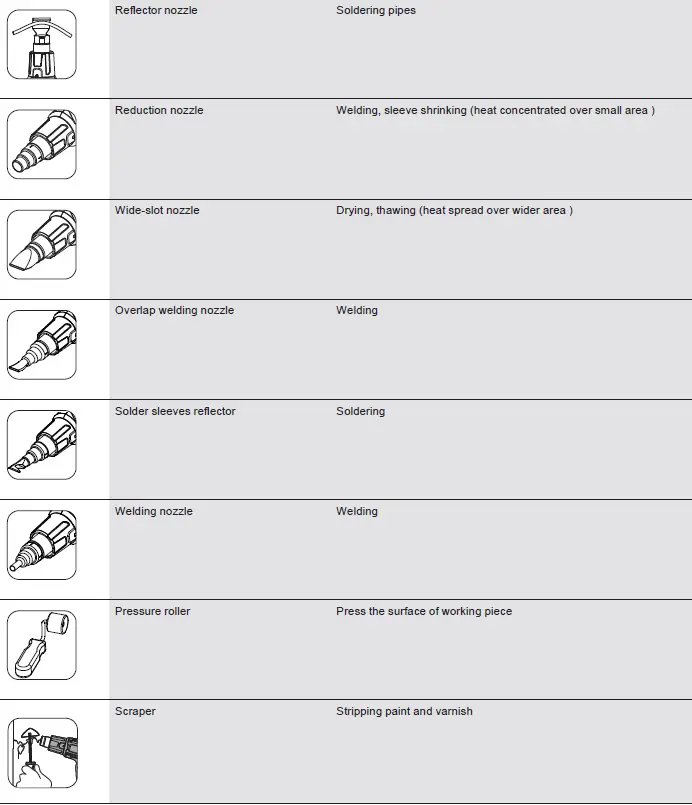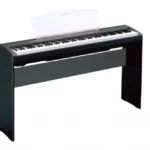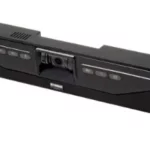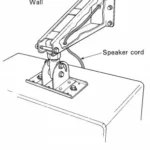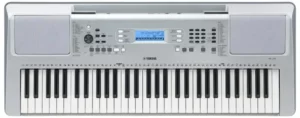
YAMAHA YPT-370 Digital Keyboard
WARNING:
This appliance cannot be used by children or persons with reduced physical, sensory or mental capabilities or lack of experience and knowledge. Children shall not play with the appliance. Cleaning and user maintenance shall not be made by children.
If the supply cord is damaged, it must be replaced by the manufacturer, its service agent or similarly qualified persons in order to avoid a hazard.
A fire may result if the appliance is not used with care, therefore:
- be careful when using the appliance in places where there are combustible materials;
- do not apply to the same place for a long time;
- do not use in presence of an explosive atmosphere;
- be aware that heat may be conducted to combustible materials that are out of sight;
- place the appliance on its stand after use and allow it to cool down before storage;
- do not leave the appliance unattended when it is switched on.
INTENDED USE
Your heat gun has been designed for stripping paint, soldering pipes, shrinking PVC, welding and bending plastic as well as general drying and thawing purposes.
WARNING:
Read this manual and general safety Instructions carefully before using the appliance, for your own safety. Your power tool should only be passed on together with these instructions.
The tool should be connected only to a power supply of the same voltage as indicated on the nameplate, and can only be operated on single-phase AC supply. They are double-insulated and can, therefore, also be used from sockets without earth wire.
Hot surfaces – Burns to fingers or hands.
DESCRIPTION
- Slide switch
- Temperature setting button (2a -, 2b+)
- Air volume setting button (3a -, 3b +)
- Confirmation button
- LCD
- Preset button
- Air inlet
- Front cover
- Nozzle

PACKAGE CONTENT LIST
Check the appliance, the power cord, the power plug and all accessories for transportation damages.
- 1 Heat gun
- 1 Set of accessories (Accessories may not be necessarily be included)
- 1 Instruction manual Packing materials are not toys! Children must not play with plastic bags! Danger of suffocation!
GENERAL POWER TOOL SAFETY WARNINGS
Read all safety warnings, instructions, illustrations and specifications provided with this power tool. Failure to follow all instructions listed below may result in electric shock, fire and/or serious injury.
Work area safety
- Keep work area clean and well lit. Cluttered or dark areas invite accidents.
- Do not operate power tools in explosive atmospheres, such as in the presence of flammable liquids, gases or dust. Power tools create sparks which may ignite the dust or fumes.
- Keep children and bystanders away while operating a power tool. Distractions can cause you to lose control.
Electrical Safety
- Power tool plugs must match the outlet. Never modify the plug in any way. Do not use any adapter plugs with earthed (grounded) power tools. Unmodified plugs and matching outlets will reduce risk of electric shock.
- Avoid body contact with earthed or grounded surfaces, such as pipes, radiators, ranges and refrigerators. There is an increased risk of electric shock if your body is earthed or grounded.
- Do not expose power tools to rain or wet conditions. Water entering a power tool will increase the risk of electric shock.
- Do not abuse the cord. Never use the cord for carrying, pulling or unplugging the power tool.
Keep cord away from heat, oil, sharp edges or moving parts. Damaged or entangled cords increase the risk of electric shock. - When operating a power tool outdoors, use an extension cord suitable for outdoor use. Use of a cord suitable for outdoor use reduces the risk of electric shock.
- If operating a power tool in a damp location is unavoidable, use a residual current device (RCD) protected supply. Use of an RCD reduces the risk of electric shock.
- Use of power supply via an RCD with a rated residual current of 30 mA or less is always recommended.
- Power tools can produce electromagnetic fields (EMF) that are not harmful to the user. However, users of pacemakers and other similar medical devices should contact the maker of their device and/or doctor for advice before operating this power tool.
- Do not touch the power plug with wet hands.
- If the cord is damaged, have it replaced by the manufacturer or his agent in order to avoid a safety hazard.
Personal Safety
- Stay alert, watch what you are doing and use common sense when operating a power tool.
Do not use a power tool while you are tired or under the influence of drugs, alcohol or medication. A moment of inattention while operating power tools may result in serious personal injury. - Use personal protective equipment. Always wear eye protection. Protective equipment such as a dust mask, non-skid safety shoes, hard hat or hearing protection used for appropriate conditions will reduce personal injuries.
- Prevent unintentional starting. Ensure the switch is in the off-position before connecting to power source and/or battery pack, picking up or carrying the tool. Carrying power tools with your finger on the switch or energising power tools that have the switch on invites accidents.
- Remove any adjusting key or wrench before turning the power tool on. A wrench or a key left attached to a rotating part of the power tool may result in personal injury.
- Do not overreach. Keep proper footing and balance at all times. This enables better control of the power tool in unexpected situations.
- Dress properly. Do not wear loose clothing or jewellery. Keep your hair and clothing away from moving parts. Loose clothes, jewellery or long hair can be caught in moving parts.
- If devices are provided for the connection of dust extraction and collection facilities, ensure these are connected and properly used. Use of dust collection can reduce dust-related hazards.
- Do not let familiarity gained from frequent use of tools allow you to become complacent and ignore tool safety principles. A careless action can cause severe injury within a fraction of a second.
- Always wear protective goggles to protect your eyes from injury when using power tools.
The goggles must comply with ANSI Z87.1 in the USA, EN 166 in Europe, or AS/NZS 1336 in Australia/New Zealand. In Australia/New Zealand, it is legally required to wear a face shield to protect your face, too.
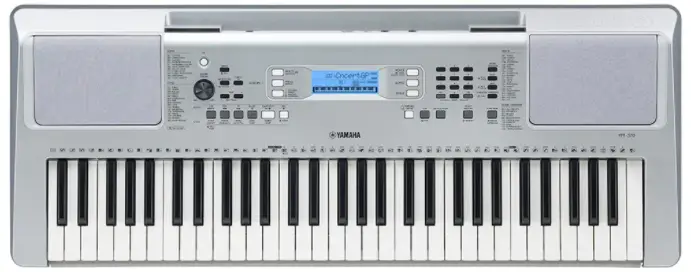 It is an employer’s responsibility to enforce the use of appropriate safety protective equipment’s by the tool operators and by other persons in the immediate working area.
It is an employer’s responsibility to enforce the use of appropriate safety protective equipment’s by the tool operators and by other persons in the immediate working area.
Power tool use and care
- Do not force the power tool. Use the correct power tool for your application. The correct power tool will do the job better and safer at the rate for which it was designed.
- Do not use the power tool if the switch does not turn it on and off. Any power tool that cannot be controlled with the switch is dangerous and must be repaired.
- Disconnect the plug from the power source and/or remove the battery pack, if detachable, from the power tool before making any adjustments, changing accessories, or storing power tools. Such preventive safety measures reduce the risk of starting the power tool accidentally.
- Store idle power tools out of the reach of children and do not allow persons unfamiliar with the power tool or these instructions to operate the power tool. Power tools are dangerous in the hands of untrained users.
- Maintain power tools and accessories. Check for misalignment or binding of moving parts, breakage of parts and any other condition that may affect the power tool’s operation. If damaged, have the power tool repaired before use.
Many accidents are caused by poorly maintained power tools. - Keep cutting tools sharp and clean. Properly maintained cutting tools with sharp cutting edges are less likely to bind and are easier to control.
- Use the power tool, accessories and tool bits etc. in accordance with these instructions, taking into account the working conditions and the work to be performed. Use of the power tool for operations different from those intended could result in a hazardous situation.
- Keep handles and grasping surfaces dry, clean and free from oil and grease. Slippery handles and grasping surfaces do not allow for safe handling and control of the tool in unexpected situations.
- When using the tool, do not wear cloth work gloves which may be entangled. The entanglement of cloth work gloves in the moving parts may result in personal injury.
Service
- Have your power tool serviced by a qualified repair person using only identical replacement parts. This will ensure that the safety of the power tool is maintained.
- Follow instruction for lubricating and changing accessories.
ADDITIONAL SAFETY INSTRUCTIONS FOR HEAT GUN
- Do not place your hand over the air vents or block the vents in any way.
- The nozzle and accessories of this tool become extremely hot during use. Let these parts cool down before touching.
- Always switch the tool off before putting it down.
- Do not leave the tool unattended while it is switched on.
- A fire may arise if the appliance is not used with care.
- Heat may be conducted to combustible materials that are out of sight. Do not use in a damp atmosphere, where flammable gases may be present or near combustible materials.
- Allow the tool to cool fully before storing.
- Ensure adequate ventilation as toxic fumes may be produced.
- Do not use as a hairdryer.
- Do not obstruct either the air intake or nozzle outlet, as this may cause excessive heat build-up resulting in damage to the tool.
- Do not direct the hot air blast at other people.
- Do not touch the metal nozzle as it becomes very hot during use and remains hot for up to 30 minutes after use.
- Do not place the nozzle against anything while using or immediately after use.
- Do not poke anything down the nozzle as it could give you an electric shock. Do not look down the nozzle while the unit is working because of the high temperature being produced.
- Do not allow paint to adhere to the nozzle or scraper as it could ignite after some time.
Removing paint
- Do not use this tool to remove paint containing lead. The peelings, residue and vapors of paint may contain lead, which is poisonous. Any pre-1960 building may have been painted in the past with paint containing lead and covered with additional layers of paint. Once deposited on surfaces, hand to mouth contact can result in the ingestion of lead. Exposure even to low levels of lead can cause irreversible damage to the brain and nervous system. Young and unborn children are particularly vulnerable.
- When removing paint, ensure that the work area is enclosed. Preferably wear a dust mask.
- Do not burn the paint. Use the scraper and keep the nozzle at least 25 mm away from the painted surface. When working in a vertical direction, work downwards to prevent paint from falling into the tool and burning.
- Dispose of all paint debris safely and ensure that the work area is thoroughly cleaned after completing the work.
MOUNTING THE CORRECT ACCESSORY (IF APPLICABLE)

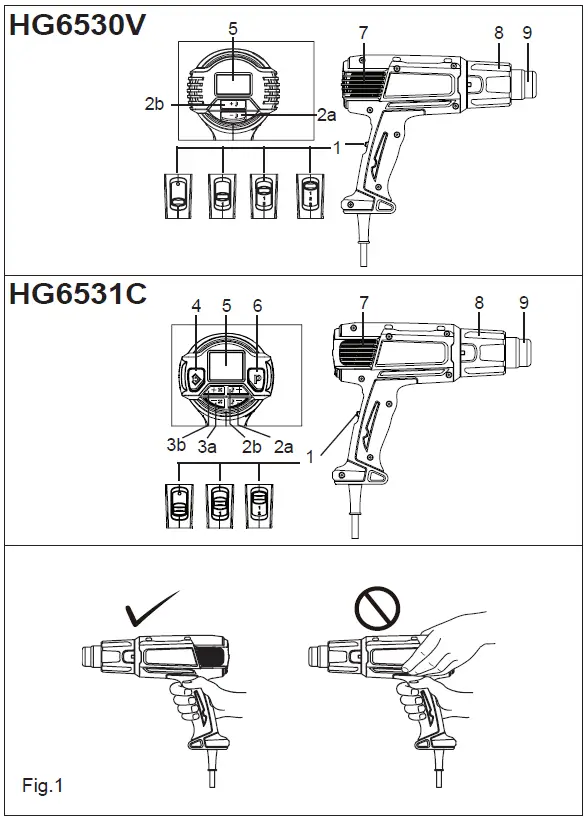
- Make sure that the tool is switched off and the nozzle has cooled down.
- Falling down nozzle may ignite objects on the floor. Nozzles must be mounted firmly and secure on the unit.
- Touching a hot nozzle can lead to serious burn. Before attaching or replacing a nozzle, allow the unit to cool down completely or use a suitable tool.
- A hot nozzle can set a surface on fire. Place down hot nozzles only on fire-proof surfaces.
- An incorrect or defective nozzle can lead to heat accumulation and damage the unit. Use only original nozzles according to the table that are suitable for your unit.
INSTRUCTIONS FOR USE
If you are not sure about the correct setting, start with a low temperature setting and gradually increase the temperature until you achieve optimum results.
- Always observe the safety instructions and applicable regulations.
- Use only one hand to hold the tool, do not place your other hand over the air vents.(Fig. 1)
- Do not use the holes on the tool housing for the fall prevention purpose at high location.
Prior to operation
- Mount the correct accessory for the application. Switching on and off
- Number of the slide switch means as follows.
HG6530V:
0: OFF position
1: For cooling down with approx. 50°C airflow
2: For heating with low air volume
3: For heating with high air volume
HG6531C:
0: OFF position
1: For cooling down with approx. 50°C airflow
2: For heating
- To switch the heat gun on, slide the slide switch (1) from 0 to one of the ON positions 1, 2 or 3.
- To switch off the heat gun, set the slide switch to position 1 to cool off for a while, and then set the slide switch to position 0 (OFF).
The heat gun may give off some smoke shortly after switching on.
This does not indicate a problem with the device.
Setting the temperature (HG6530V)
The temperature can be set with the slide switch (1) at position 2 or 3.
- Press the temperature setting button + (2b) to increase the temperature, and – (2a) to decrease the temperature. The LCD (5) displays the present temperature of the airflow few seconds after the target temperature was set.
- To switch the unit of the temperature between °C or °F, press + and – together.
Selecting the preset mode (HG6531C)
14 preset modes are available to quickly set the temperature and air volume suitable for major applications.
Select the desired preset application as follows.
- Set the slide switch (1) at position 2. The LCD (5) displays the application name that was used at the last time, and corresponding temperature and air volume settings. Few seconds later, the LCD displays the present temperature of the airflow.
- Press the preset button (6). The application name starts to scroll.
- Press the temperature setting buttons (2a/b) or air volume setting buttons (3a/b) to select the application. When the desired application name is displayed on the LCD, press the confirmation button (4) to decide it.
Whenever a setting is not confirmed by pressing the confirmation button (4) within 5-6 seconds, the device reverts to the previously confirmed setting.
Setting the temperature and air volume (HG6531C)
Change the temperature and air volume as follows.
With the slide switch (1) at position 1, only the air volume can be changed.
With the slide switch at position 2, this procedure overwrites the preset temperature and air volume of the application currently displayed on the LCD.
- Set the slide switch (1) at position 1 or 2.
- Press the temperature setting buttons (2a/b) to change the temperature. Press the air volume setting buttons (3a/b) to change the air volume.
The indications of temperature and air volume on the LCD (5) start to blink. - Press the confirmation button (4) to confirm the setting.
The temperature and air volume on the LCD stop blinking. Few seconds later, the LCD displays the present temperature of the airflow.
Whenever a setting is not confirmed by pressing the confirmation button (4) within 5-6 seconds, the device reverts to the previously confirmed setting.
MAINTENANCE AND CLEANING
Attention: Before performing any work on the equipment, pull the power plug.
Maintenance
Your Power Tool has been designed to operate over a long period of time with a minimum of maintenance. Continuous satisfactory operation depends upon proper tool care and regular cleaning.
Lubrication
Your power tool requires no additional lubrication.
Cleaning
- To prevent overheating of the motor, keep the ventilation slots of the machine clean and free from dust and dirt.
- Regularly clean the machine housing with a soft cloth, preferably after each use. If the dirt does not come off use a soft cloth moistened with soapy water.
Never use solvents such as petrol, alcohol, ammonia water, etc. These solvents may damage the plastic parts.
TECHNICAL DATA
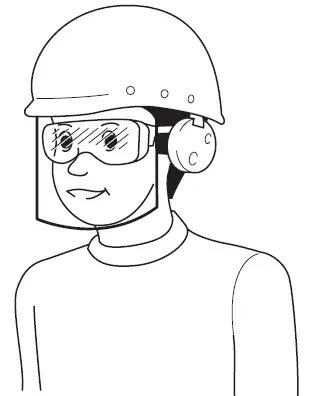
Default setting of the preset mode

ENVIRONMENT
Should your appliance need replacement after extended use, do not discard it with the household rubbish but dispose of it in an environmentally safe way.
Waste produced by electrical machine items should not be handled like normal household rubbish. Please recycle where facilities exist. Check with your Local Authority or retailer for recycling advice.
Subject to change without notice.
